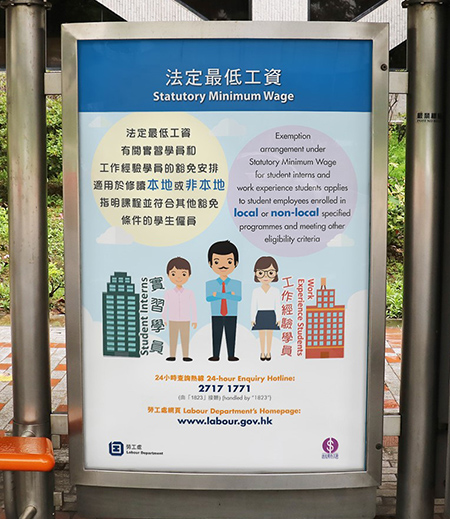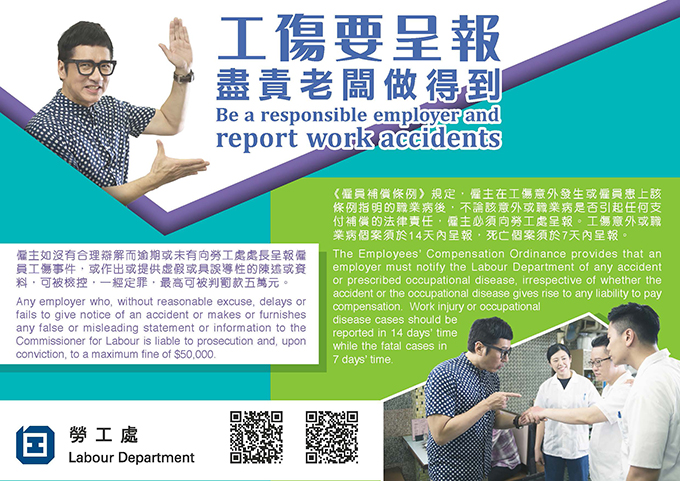Chapter 6 Employees’ Rights and Benefits
The Programme of Employees’ Rights and Benefits
www.labour.gov.hk/eng/erb/content.htm
6.1The objective of the Employees’ Rights and Benefits Programme is to improve and safeguard employees’ rights and benefits in an equitable manner. Our aim is to progressively enhance employment standards in a way which is commensurate with the pace of Hong Kong’s economic and social developments and which takes into account the interests of employers and employees. We achieve this by:
- setting and refining employment standards in consultation with the Labour Advisory Board;
- ensuring compliance with statutory and contractual terms and conditions of employment through inspection of workplaces, investigation into suspected breaches of the statutory provisions and prosecution of offenders;
- processing employees’ compensation claims;
- processing applications for ex gratia payment from the Protection of Wages on Insolvency Fund (PWIF);
- maintaining close partnership with statutory bodies set up for protecting the rights and benefits of employees; and
- providing customer-oriented information to ensure that employees and employers know their rights and obligations.
6.2The principal legislation administered by this programme area includes the Employees’ Compensation Ordinance (ECO), the Pneumoconiosis and Mesothelioma (Compensation) Ordinance (PMCO), the Occupational Deafness (Compensation) Ordinance (ODCO), the Employees Compensation Assistance Ordinance (ECAO), the Employment Ordinance (EO) and its subsidiary Employment of Children Regulations and Employment of Young Persons (Industry) Regulations, the Minimum Wage Ordinance (MWO), the Protection of Wages on Insolvency Ordinance (PWIO) as well as Part IVB of the Immigration Ordinance.
6.3The ECO establishes a no-fault, non-contributory employees’ compensation system so that individual employers are liable to pay compensation for work-related injuries and fatalities. It requires all employers to possess valid insurance policies to cover their liabilities under the laws (including the common law).
6.4The PMCO provides for compensation payable to persons who suffer from pneumoconiosis and/or mesothelioma and family members of persons who die of these diseases. Compensation is paid from the Pneumoconiosis Compensation Fund, which is administered by the Pneumoconiosis Compensation Fund Board.
6.5The ODCO provides for compensation payable to persons who suffer from noise-induced deafness by reason of employment in specified noisy occupations. Compensation is paid from the Occupational Deafness Compensation Fund, which is administered by the Occupational Deafness Compensation Board.
6.6The ECAO establishes the Employees Compensation Assistance Fund to provide assistance payment to injured employees and family members of deceased employees who are unable to receive their entitlements for work-related injuries and fatalities from employers and insurers. The fund is administered by the Employees Compensation Assistance Fund Board.
6.7The EO is the main piece of legislation governing conditions of employment. The Employment of Children Regulations made under the EO prohibit the employment of children below the age of 15 in industrial undertakings and regulate the employment of children who have attained the age of 13 but under 15 in non-industrial establishments. The Employment of Young Persons (Industry) Regulations set out requirements on the working time arrangements for young persons employed in the industrial sector and prohibit their employment in dangerous trades.
6.8The MWO establishes a Statutory Minimum Wage (SMW) system which provides a wage floor with a view to forestalling excessively low wages, but without unduly jeopardising Hong Kong’s labour market flexibility, economic growth and competitiveness or leading to significant adverse impact on the employment opportunities of vulnerable workers. Failure to pay the SMW amounts to a breach of the wage provisions under the EO.
6.9The PWIO establishes the PWIF to provide timely relief in the form of ex gratia payment to employees affected by their insolvent employers.
6.10The Labour Department (LD) also administers Part IVB of the Immigration Ordinance to combat illegal employment in order to protect the employment opportunities of local workers.
Our Work and Achievements in 2020
Key Indicators of Work
6.11We sustained our efforts to safeguard the rights and benefits of employees through various activities in 2020. Some key indicators of work of this programme area are shown in Figure 6.1.
Proactive Efforts to Combat Wage Defaults
6.12In 2020, the LD continued to adopt a proactive strategy to tackle the problem of non-payment of wages at source through enhancing publicity and promotion, taking enforcement and prosecution actions, and making use of the early warning system set up in collaboration with trade unions to gather relevant intelligence. We also proactively monitored selected sectors and establishments with a view to forestalling and detecting cases of wage default at an early stage and intervening early to tackle the problem.
6.13We continued to take enforcement and prosecution actions against employers and responsible individuals of companies for wage offences. We conducted territory-wide inspections of workplaces to detect wage offences. Labour inspectors actively interviewed employees during inspections and conducted investigation speedily into the suspected offences. Prosecutions were taken out whenever sufficient evidence was available.
6.14During the year, the LD secured 565 convicted summonses for wage offences and 143 convicted summonses for defaults of awards made by the Labour Tribunal (LT) or the Minor Employment Claims Adjudication Board (MECAB). A total of two company directors were sentenced to imprisonment for these offences, and another four company directors and one employer were ordered to perform community service. These sentences disseminated a strong message to employers and company responsible individuals on the seriousness of defaults of wages and awards made by the LT or the MECAB.
Vigorous Enforcement to Protect Employees’ Rights and Benefits
6.15The LD continued vigorous enforcement efforts to ensure that the statutory rights of employees under labour legislation were well protected.
6.16In 2020, labour inspectors carried out 104 138 workplace inspections of establishments in various trades to enforce labour laws (Figure 6.2), of which 41 539 inspections were conducted to check compliance with the MWO.
6.17We conducted inspections and trade-targeted operations to enforce the ECO’s compulsory requirement of taking out employees’ compensation insurance policy. In the year, a total of 80 430 inspections were conducted to enforce the statutory requirement.
6.18We continued to work closely with government departments in monitoring their service contractors to ensure that non-skilled employees of the contractors enjoyed their rights and benefits. A total of 657 inspections were conducted to the workplaces of such workers and 2 294 workers were interviewed to check contractors’ compliance with labour laws.
6.19To ensure compliance with the conditions under the Supplementary Labour Scheme, we investigated 87 complaints and cases on suspected irregularities involving imported workers. Items investigated included wages and working hours arrangement.
Processing Employees’ Compensation Cases and Improving Work Injury Protection for Employees
6.20Under the current no-fault employees’ compensation system, compensation is payable to injured employees or family members of deceased employees for any work-related injuries or fatalities. Claims for compensation involving fatality are determined by the courts or, under the improved settlement mechanism introduced in August 2000, by the Commissioner for Labour.
6.21In 2020, 38 756 employees’ compensation cases, including 10 269 minor cases which involved sick leave of not exceeding three days, were received. At year-end, among the 28 487 fatal cases or non-fatal cases involving sick leave exceeding three days, 13 692 cases were settled. The amount of employees’ compensation involved was $150 million. The remaining cases were pending expiry of employees’ sick leave, assessment of permanent incapacity or court judgment. (Figures 6.3 and 6.4)
6.22The LD enhanced the Claims Support Services through dedicated follow-up, early intervention, proactive contact and arrangement of face-to-face meetings when necessary, to facilitate timely resolution of differences between employers and employees in employees’ compensation cases.
6.23The Task Force on Improving Work Injury Protection for Employees in High-risk Industries (Task Force) coordinated by the LD continued to implement improvement measures including stepping up the publicity and promotion of taking out adequate employees’ compensation insurance coverage by employers, enhancing the case processing of employees’ compensation claims, shortening the waiting time of injured employees for work injury assessments and strengthening training on occupational medicine. The Task Force will continue to discuss and implement other improvement measures.
Briefings and Promotional Campaigns
6.24In 2020, the LD arranged a briefing for government departments and 30 briefings for imported workers to publicise the rights and obligations of the parties concerned.
6.25Extensive publicity campaigns were launched to publicise our complaint telephone hotline (2815 2200) through public transportation network, bus interchanges, advertisements inside MTR stations and compartments, newspaper articles, etc. to encourage employees to report suspected breaches of employment rights.
6.26We organised a wide range of publicity activities to enhance public awareness of the SMW rate and the MWO during the year. These activities included broadcasting TV and Radio Announcements in the Public Interest (APIs) through different media, distributing and displaying leaflets and posters, holding seminars and roving exhibitions, publishing feature articles and comics in newspapers, launching online interactive games, and placing advertisements through various channels such as newspapers, mobile applications, Internet platforms and public transport.

Advertisements placed in mobile applications and on online platforms to promote the Statutory Minimum Wage online interactive game
6.27We continued to promote employers’ statutory obligations on timely reporting of work accidents and taking out employees’ compensation insurance policies through APIs, advertisements on public transport, leaflets distributed and posters displayed through various channels, publicity messages delivered through journals of workers’ unions and trade associations, and publicity at departmental homepage.
Partnership with Statutory Bodies
6.28We maintain close partnership with various statutory bodies that have been set up for implementing the different schemes for the protection of the rights and benefits of employees.
Protection of Wages on Insolvency Fund Board (PWIFB)
6.29The PWIFB established under the PWIO is responsible for administering the PWIF. Employees who are owed wages, wages in lieu of notice, severance payment, pay for untaken annual leave and pay for untaken statutory holidays by their insolvent employers may apply for ex gratia payment from the PWIF in accordance with the PWIO. The PWIF is mainly financed by a levy on business registration certificates.
6.30The LD provides administrative support to the PWIFB, verifies applications and approves ex gratia payment from the PWIF. In 2020, we received 3 020 applications and processed 2 753 applications from employees who were owed wages and other statutory entitlements due to business cessation and sought relief from the PWIF, with ex gratia payment of $78.5 million made. A breakdown of applications received by economic sector is shown in Figure 6.5.
6.31By providing a safety net for employees affected by business closures, the PWIF plays an important role in maintaining good labour relations and social stability. Both the LD and the PWIFB attach great importance to protecting the PWIF from possible abuse. To this end, stringent vetting procedures are in place to process all applications. An inter-departmental task force has been formed by representatives of the LD, the Commercial Crime Bureau of the Hong Kong Police Force, the Official Receiver’s Office and the Legal Aid Department to take concerted actions against suspected fraudulent cases.
Pneumoconiosis Compensation Fund Board (PCFB)
6.32The PCFB is established under the PMCO to provide compensation to persons suffering from pneumoconiosis and/or mesothelioma and family members of persons who die of these diseases. The PCFB is financed by a levy collected from the construction and quarrying industries. Under the PMCO, the LD is responsible for determining whether an applicant is entitled to compensation. As at the end of 2020, 1 433 eligible persons were receiving compensation in the form of monthly payments from the PCFB. In the year, the PCFB made a total compensation payment of $209 million.
Occupational Deafness Compensation Board (ODCB)
6.33Established under the ODCO, the ODCB provides compensation for persons who suffer from noise-induced deafness by reason of employment in specified noisy occupations and financial assistance for their purchase, fitting, repair or maintenance of hearing assistive devices. The ODCB also has an important role in launching educational and publicity programmes for the prevention of occupational deafness, and providing rehabilitation programmes for those suffering from occupational deafness. In 2020, the ODCB approved 91 applications for compensation with a total compensation payout at $8.91 million and 653 applications for payment of expenses on hearing assistive devices with a total payout at $3.81 million. The ODCB also provided 571 rehabilitation programmes for people with hearing impairment caused by their employment in specified noisy occupations.
Employees Compensation Assistance Fund Board (ECAFB)
6.34The ECAFB is set up under the ECAO. It is responsible for administering the Employees Compensation Assistance Fund which provides assistance payment to eligible injured employees and family members of deceased employees who are unable to receive their entitlements for work-related injuries and fatalities from employers and insurers after exhausting all legal and financially viable means of recovery. In 2020, the ECAFB approved 37 applications, leading to payment of $42.90 million.

